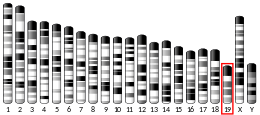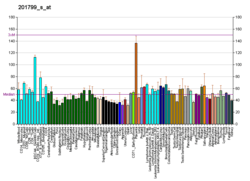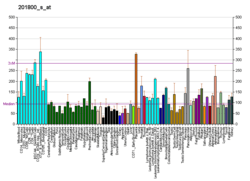OSBP
Oxysterol-binding protein 1 is a protein that in humans is encoded by the OSBP gene.[5]
Function
Oxysterol-binding protein (OSBP) is an intracellular protein that was identified as a cytosolic 25-hydroxycholesterol-binding protein.[6] OSBP is a lipid transfer protein that controls cholesterol/PI4P exchange at ER-Golgi membrane contact sites.[7] 25-hydroxycholesterol acts as a natural inhibitor of this exchange. OSBP regulates ER-Golgi membrane contact sites formation by bridging ER and Golgi membranes together.[7] OSBP plays also a role as a sterol-regulated scaffolding protein for several cytosolic reactions including the phosphorylation of ERK 1/2.[8]
It has been shown that expression and maturation of SREBP-1c is controlled by OSBP.[9] SREBP-1c is a major transcription factor for hepatic lipogenesis (fatty acids and triglycerides biosynthesis). OSBP expression levels in transgenic mice affect liver and serum TG levels. OSBP is thought to be an essential scaffolding compound of the protein complex that regulates the activation state of the ERK protein.[8] OSBP also acts as a sterol-dependant scaffold for the JAK2 and STAT3 proteins.[10]
Mechanism of action
OSBP is a multi-domain protein consisting of an N-terminal pleckstrin homology (PH) domain, a central FFAT motif (two phenylalanines in an acidic track), and a C-terminal lipid transport domain (ORD). The PH domain binds the trans-Golgi membrane by contacting the lipid PI4P and the activated small G protein Arf1(-GTP), whereas the FFAT motif binds the type II ER membrane protein VAP-A.[11][12] OSBP bridges the Golgi and the ER by establishing contacts with all of these determinants simultaneously.[7]
OSBP is thought to transport cholesterol from the ER to the Golgi, and to transport the phosphoinositide PI4P backward (from the Golgi to the ER).[7] Then, PI4P can be hydrolyzed by the phosphatidylinositide phosphatase SAC1, which is an ER-resident protein. Therefore, OSBP acts as a negative regulator of its own attachment to the trans-Golgi (which requires the binding of its PH domain to PI4P). This negative feedback system might coordinate cholesterol transport out of the ER to PI4P level in the Golgi.
Regulation
OSBP is regulated by PKD mediated phosphorylation, and by the oxysterol 25-hydroxycholesterol (25-OH), a high-affinity ligand for OSBP (~30 nM).[6][13] Several proteins involved in cholesterol homeostasis, such as INSIG-1 or ACAT, also bind 25-OH.[14] In fact 25-OH is a potent suppressor of sterol synthesis in cultured cells and accelerates cholesterol esterification. In cellular studies it has been shown that OSBP, initially cytosolic, relocates to ER-Golgi membrane contact sites in the presence of 25-OH.[6] 25-OH acts as an inhibitor of sterol transport mediated by OSBP in vitro.[7]
Isoforms
OSBP is the founding member of the ORP (OSBP-related proteins) family of lipid transfer proteins. Mammals have 16 different ORPs, whereas the yeast S. cerevisiae genome encodes seven ORP homologues (Osh). ORP and Osh proteins contain a lipid transport domain called ORD (OSBP-related domain) encompassing the EQVSHHPP signature sequence.[15] The ORD structure consists in a hydrophobic pocket. Because the EQVSHHPP sequence is crucial for PI4P binding to the ORD, but not for sterol binding, it has been proposed that PI4P transport is a common function of Osh/ORP proteins.[16]
References
- 1 2 3 GRCh38: Ensembl release 89: ENSG00000110048 - Ensembl, May 2017
- 1 2 3 GRCm38: Ensembl release 89: ENSMUSG00000024687 - Ensembl, May 2017
- ↑ "Human PubMed Reference:".
- ↑ "Mouse PubMed Reference:".
- ↑ "Entrez Gene: OSBP oxysterol binding protein".
- 1 2 3 Ridgway ND, Dawson PA, Ho YK, Brown MS, Goldstein JL (January 1992). "Translocation of oxysterol binding protein to Golgi apparatus triggered by ligand binding". J. Cell Biol. 116 (2): 307–19. PMC 2289278
 . PMID 1730758. doi:10.1083/jcb.116.2.307.
. PMID 1730758. doi:10.1083/jcb.116.2.307. - 1 2 3 4 5 Mesmin B, Bigay J, Moser von Filseck J, Lacas-Gervais S, Drin G, Antonny B (November 2013). "A Four-Step Cycle Driven by PI(4)P Hydrolysis Directs Sterol/PI(4)P Exchange by the ER-Golgi Tether OSBP". Cell. 155 (4): 830–43. PMID 24209621. doi:10.1016/j.cell.2013.09.056.
- 1 2 Wang PY, Weng J, Anderson RG (March 2005). "OSBP is a cholesterol-regulated scaffolding protein in control of ERK 1/2 activation". Science. 307 (5714): 1472–6. PMID 15746430. doi:10.1126/science.1107710.
- ↑ Yan D, Lehto M, Rasilainen L, Metso J, Ehnholm C, Ylä-Herttuala S, Jauhiainen M, Olkkonen VM (May 2007). "Oxysterol binding protein induces upregulation of SREBP-1c and enhances hepatic lipogenesis". Arterioscler. Thromb. Vasc. Biol. 27 (5): 1108–14. PMID 17303778. doi:10.1161/ATVBAHA.106.138545.
- ↑ Romeo GR, Kazlauskas A (April 2008). "Oxysterol and diabetes activate STAT3 and control endothelial expression of profilin-1 via OSBP1". J. Biol. Chem. 283 (15): 9595–605. PMID 18230613. doi:10.1074/jbc.M710092200.
- ↑ Levine T (September 2004). "Short-range intracellular trafficking of small molecules across endoplasmic reticulum junctions". Trends Cell Biol. 14 (9): 483–90. PMID 15350976. doi:10.1016/j.tcb.2004.07.017.
- ↑ Wyles JP, McMaster CR, Ridgway ND (August 2002). "Vesicle-associated membrane protein-associated protein-A (VAP-A) interacts with the oxysterol-binding protein to modify export from the endoplasmic reticulum". J. Biol. Chem. 277 (33): 29908–18. PMID 12023275. doi:10.1074/jbc.M201191200.
- ↑ Nhek S, Ngo M, Yang X, Ng MM, Field SJ, Asara JM, Ridgway ND, Toker A (July 2010). "Regulation of oxysterol-binding protein Golgi localization through protein kinase D-mediated phosphorylation". Mol. Biol. Cell. 21 (13): 2327–37. PMC 2893995
 . PMID 20444975. doi:10.1091/mbc.E10-02-0090.
. PMID 20444975. doi:10.1091/mbc.E10-02-0090. - ↑ Radhakrishnan A, Ikeda Y, Kwon HJ, Brown MS, Goldstein JL (April 2007). "Sterol-regulated transport of SREBPs from endoplasmic reticulum to Golgi: oxysterols block transport by binding to Insig". Proc. Natl. Acad. Sci. U.S.A. 104 (16): 6511–8. PMC 1851665
 . PMID 17428920. doi:10.1073/pnas.0700899104.
. PMID 17428920. doi:10.1073/pnas.0700899104. - ↑ Im YJ, Raychaudhuri S, Prinz WA, Hurley JH (September 2005). "Structural mechanism for sterol sensing and transport by OSBP-related proteins". Nature. 437 (7055): 154–8. PMC 1431608
 . PMID 16136145. doi:10.1038/nature03923.
. PMID 16136145. doi:10.1038/nature03923. - ↑ de Saint-Jean M, Delfosse V, Douguet D, Chicanne G, Payrastre B, Bourguet W, Antonny B, Drin G (December 2011). "Osh4p exchanges sterols for phosphatidylinositol 4-phosphate between lipid bilayers". J. Cell Biol. 195 (6): 965–78. PMC 3241724
 . PMID 22162133. doi:10.1083/jcb.201104062.
. PMID 22162133. doi:10.1083/jcb.201104062.
Further reading
- Levanon D, Hsieh CL, Francke U, Dawson PA, Ridgway ND, Brown MS, Goldstein JL (May 1990). "cDNA cloning of human oxysterol-binding protein and localization of the gene to human chromosome 11 and mouse chromosome 19". Genomics. 7 (1): 65–74. PMID 1970801. doi:10.1016/0888-7543(90)90519-Z.
- Laitinen S, Olkkonen VM, Ehnholm C, Ikonen E (December 1999). "Family of human oxysterol binding protein (OSBP) homologues. A novel member implicated in brain sterol metabolism". J. Lipid Res. 40 (12): 2204–11. PMID 10588946.
- Moreira EF, Jaworski C, Li A, Rodriguez IR (May 2001). "Molecular and biochemical characterization of a novel oxysterol-binding protein (OSBP2) highly expressed in retina". J. Biol. Chem. 276 (21): 18570–8. PMID 11278871. doi:10.1074/jbc.M011259200.
- Jaworski CJ, Moreira E, Li A, Lee R, Rodriguez IR (December 2001). "A family of 12 human genes containing oxysterol-binding domains". Genomics. 78 (3): 185–96. PMID 11735225. doi:10.1006/geno.2001.6663.
- Beausoleil SA, Jedrychowski M, Schwartz D, Elias JE, Villén J, Li J, Cohn MA, Cantley LC, Gygi SP (August 2004). "Large-scale characterization of HeLa cell nuclear phosphoproteins". Proc. Natl. Acad. Sci. U.S.A. 101 (33): 12130–5. PMC 514446
 . PMID 15302935. doi:10.1073/pnas.0404720101.
. PMID 15302935. doi:10.1073/pnas.0404720101. - Perry RJ, Ridgway ND (June 2006). "Oxysterol-binding protein and vesicle-associated membrane protein-associated protein are required for sterol-dependent activation of the ceramide transport protein". Mol. Biol. Cell. 17 (6): 2604–16. PMC 1474796
 . PMID 16571669. doi:10.1091/mbc.E06-01-0060.
. PMID 16571669. doi:10.1091/mbc.E06-01-0060.





